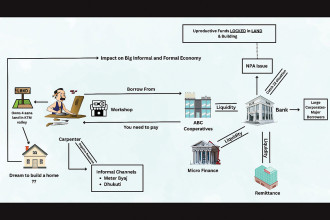
Nepal has been persistently facing a situation of trade deficit over the last several decades. This is primarily attributed to weak supply-side capacity, unfavourable market access conditions and higher transportation costs, among others. The disadvantage associated with geography has affected various sectors of the economy, including the regimes of foreign direct investment, as defined by the declining trend of manufacturing industries over the last two decades or so.
Agriculture has become the mainstay of Nepali economy as 60% of the population is still engaged in some sort of agribusiness for their livelihood. However, its share in the GDP is on a declining trend, now hovering around 24%. In the industrial sector, manufacturing contributed around 12% to the GDP during the 1990s, which has been decelerating and is now coming down to 5%. The services sector now contributes 62% to the GDP and has seen impressive growth, particularly in wholesale and retail trade, accommodation and food services, real estate business, and travel and transportation.
The structure of the economy was thus shaped by premature de-industrialisation with the jump from agriculture to services leaving the industry and manufacturing sector behind. On the other hand, the adoption of fast-developing modern technologies by the industries has impacted the dynamics of the labour market as the increasing number of workforce in the market misses the employment and income opportunities in the domestic front. The exodus of a large number of young people every year is also attributed to the asymmetric development and lack of decent employment opportunities at home.
Services as a whole are the emerging sectors of the Nepali economy as this comprises three-fifths of the GDP composition. According to the Nepal Statistical Yearbook 2023, published by Nepal Statistical Office, wholesale and retail trade services rank top with a share of 13.84%, while the travel and tourism sub-sector (classified under the headings of accommodation and food services and transportation) made up 6.6% of GDP in 2023.
The relevance of services is more prominent in the context of coping with trade deficit challenges being faced by the country. The gap between import and export volume and value is increasing on a year-on-year basis. The import figure is on a constant rise, while the export figure seems erratic, mostly static and often falling back. A sudden surge in export experienced in past years is backed by the export of vegetable oil and fats; exported taking advantage of duty differences between Nepal and India rather than for its competitiveness.
Alternative means of arresting the pace of imbalances in merchandise trade is the services sector. Five service sub-sectors have been identified by the Government of Nepal as having the most potential for export, as indicated by the Nepal Trade Integration Strategy-2023. These sub-sectors are tourism, information technology, hydro-energy, construction, and skilled and semi-skilled human resources (as classified under Mode 4 of the WTO Trade in Services Agreement).
Tourism has been recognised as the most promising service sub-sector by previous trade integration strategies developed since 2004. Nepal has the potential to attract a large number of tourists, which could help bring foreign currency into the country as well as create employment opportunities for a large number of people. The country was regarded as Shangri-la among Western visitors during the 1970s and 80s when the hippie culture was thriving. Trekking, mountaineering, sightseeing and enjoying the beauty of nature were the primary objectives of visitors during that period. Gradually, tourism products diversified in the following decades, expanding to include entertainment and adventure tourism such as paragliding, bungee jumping, rock climbing, as well as event tourism like meetings, conferences and social events like marriages and birthdays. Another significant tourism product is exchange of religious visits at the cross-border level. The triangular tourism circuit among Nepal, India and Tibet, China is operational for the people of the Hindu and Buddhist faiths. Such religious visits between the neighbouring countries had existed since time immemorial.
India is the largest source of tourists visiting Nepal. The recorded number of Indian tourist arrival in 2023 was 323,000, which is almost 32% of the total arrivals in the year. This was followed by the USA (10%) and China (6%). The United Kingdom, Australia, Bangladesh and Thailand are the other source countries of tourism for Nepal. Foreign exchange earnings from tourism in 2022-23 stood at 33.5% of the merchandise exports.
Given the declining competitiveness of goods trade, there is considerable potential to increase export earnings from the tourism sector to fill the void. However, the government is required to develop appropriate strategies to enhance the contribution of the tourism sector to economic growth and create productive employment in the country.
Focus should be given to developing additional tourism products that are of high standards and meet the quality desired by the prospective users. Emphasis should be given to the promotion of eco-tourism, using the natural resources of the country, like rivers, lakes, mountains and forests. Preservation of the natural heritage and sites should be given high priority. It is important to create a unique and splendid destination based on culture, heritage and a storehouse of traditional knowledge that would be different from destinations elsewhere in the region.
Secondly, the government, as well as the private sector, should undertake aggressive marketing in the two neighbouring countries, as these countries comprise a substantial number of travellers departing the country every year. One recent estimate shows that roughly 27.8 million Indians and 101 million Chinese took an outbound tour in 2023. Nepal could increase the number of visiting tourists from these countries by following the proper marketing strategies.
Nepal should focus on strengthening the transport infrastructure and recreational services to attract international visitors and lengthen their stay. Particular attention is needed to improve the safety of road and air transport services. Many potential tourist sites are still not connected to the national transport network. Hence, the expansion of road services and the construction of new roads should also be evaluated from the perspective of promoting tourism.
Social inclusion and participation of micro and small enterprises is the cornerstone for enhancing contribution of tourism sector to poverty reduction initiatives and increase employment opportunities. This requires integrating local artisan products, souvenir items, organic agriculture and eco-tourism into the tourism industry.
Nepal, with its diverse nature and ecological belts, ranging from high mountains to lower plains, has a high potential for attracting foreign tourists. The country needs alternative sources of foreign currency earnings, away from remittances, which could be volatile in the context of growing conflict between nations. Tourism can be such an opening to relieve the uncertainties posed by remittance incomes and the underperformance of goods exports. The imperative lies in developing a strategic plan for the enhancement of the tourism industry so that it helps to improve the resiliency of the balance of payments and creates productive employment within the country.





-1758271497.jpg)
